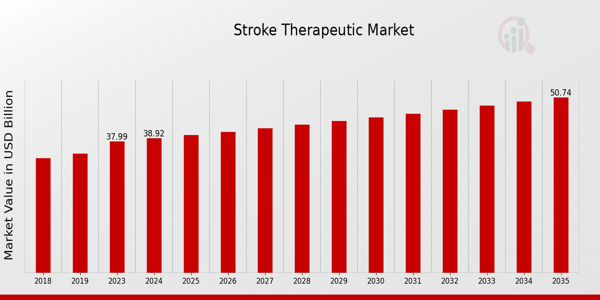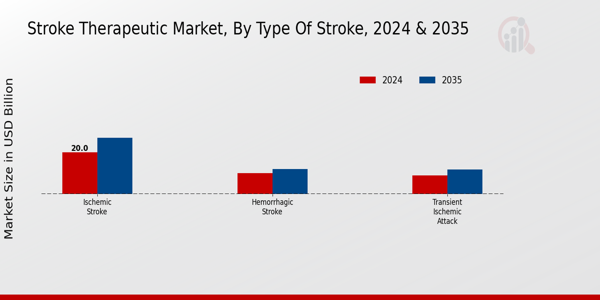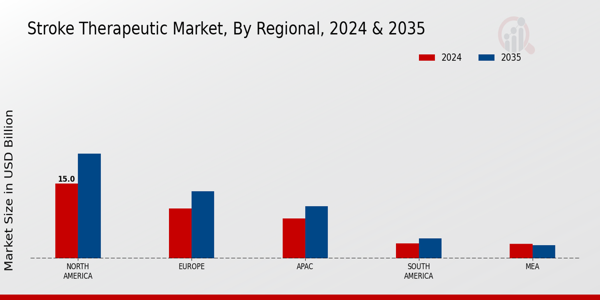Stroke Therapeutic Market Overview
As per MRFR analysis, the Stroke Therapeutic Market Size was estimated at 37.99 (USD Billion) in 2023. The Stroke Therapeutic Market Industry is expected to grow from 38.92(USD Billion) in 2024 to 50.7 (USD Billion) by 2035. The Stroke Therapeutic Market CAGR (growth rate) is expected to be around 2.44% during the forecast period (2025 - 2035).
Key Stroke Therapeutic Market Trends Highlighted
The Stroke Therapeutic Market is experiencing significant growth driven by rising incidences of stroke globally, increased awareness about stroke management, and advancements in medical technology. The aging population contributes heavily to this trend, as older individuals are at a higher risk for stroke. Furthermore, the rise in lifestyle-related diseases, such as diabetes and hypertension, is escalating the demand for effective therapeutic solutions. Healthcare professionals now have access to improved diagnostic tools, allowing for earlier detection and timely intervention, which enhances patient outcomes and broadens treatment options.
There are various opportunities to be explored within this market. Developing countries present untapped potential due to increasing healthcare expenditures and growing awareness of stroke management. Emerging technologies, such as telemedicine and mobile health apps, can facilitate remote monitoring and management of patients, broadening access to care. Additionally, research into novel therapies and medications could lead to breakthrough treatments that may better manage stroke-related conditions. Companies willing to invest in these areas stand to gain a competitive advantage in a rapidly evolving market. Recent trends indicate a shift toward personalized medicine in stroke therapy, with more treatments being tailored to individual patient needs.
There is also a focus on rehabilitation technologies, including robotic-assisted therapies and virtual reality, aimed at improving recovery times and outcomes. Increasing collaboration between pharmaceutical companies and technology firms is reshaping how stroke therapies are developed and delivered. This convergence of technology and healthcare is pivotal in creating more effective solutions for patients suffering from stroke and highlights the dynamic nature of the market. Such developments not only enhance care but also help address the growing global burden of stroke.

Source: Primary Research, Secondary Research, MRFR Database and Analyst Review
Stroke Therapeutic Market Drivers
Increasing Prevalence of Stroke
The rise in the incidence of stroke cases globally serves as a primary driving factor in the Stroke Therapeutic Market Industry. Stroke occurrence is linked to a higher number of risk factors, including but not limited to hypertension, diabetes, and unhealthy lifestyle choices like poor diet and lack of physical activity. As the world's population continues to grow and age, the prevalence of these risk factors is also expected to rise, leading to an increase in the number of people affected by strokes.
This uptrend creates a higher demand for effective therapeutic solutions to manage, treat, and rehabilitate stroke patients, contributing to the growth of the market. Stakeholders in the Stroke Therapeutic Market Industry must also consider the increased awareness and improved diagnostic methods that help in the early identification of stroke cases, which further amplifies the need for advanced therapeutics. Additionally, countries with rapidly aging populations are projected to experience a marked rise in stroke cases, demanding more innovative treatments and therapies to address these health challenges.
This demographic trend will likely boost market growth as healthcare systems adapt to meet the rising demand for stroke management and rehabilitation services.
Advancements in Medical Technology
Technological advancements in the development of medical devices, pharmaceuticals, and therapeutic techniques are significantly impacting the Stroke Therapeutic Market Industry. Innovations such as minimally invasive surgical procedures, enhanced imaging technologies, and breakthrough drug formulations are revolutionizing the way strokes are treated. These advancements not only improve patient outcomes but also elevate the standard of care available to stroke patients, thereby fostering a more robust market environment.
With advances in technology, healthcare professionals are increasingly able to mitigate and control stroke events. This ecosystem of innovation further fuels the market’s growth potential.
Government Initiatives and Funding
An increase in government initiatives and funding aimed at stroke research and care plays a vital role in bolstering the Stroke Therapeutic Market Industry. Policymakers are recognizing the significant burden strokes place on healthcare systems and are increasingly allocating resources to improve stroke prevention, treatment and rehabilitation programs. This financial commitment not only supports the development of innovative therapeutics but also enhances public awareness campaigns about the importance of recognizing stroke symptoms and reducing risk factors.
Furthermore, government incentives and grants for research institutions and pharmaceutical companies to explore new therapeutic approaches contribute to a more active and competitive market landscape.
Stroke Therapeutic Market Segment Insights
Stroke Therapeutic Market Type of Stroke Insights
The Stroke Therapeutic Market is experiencing notable growth, with a total projected market valuation of 38.92 USD Billion in 2024, increasing to 50.7 USD Billion by 2035. This market segmentation focuses on the Type of Stroke, which includes Ischemic Stroke, Hemorrhagic Stroke, and Transient Ischemic Attack. Ischemic Stroke is a dominant player in this market, boasting a valuation of 20.0 USD Billion in 2024 and expected to rise to 27.0 USD Billion by 2035, reflecting its majority holding in the stroke therapeutic landscape. This segment is significant as it accounts for nearly 87% of all strokes, making effective therapeutic options essential for patient recovery and quality of life.
Hemorrhagic Stroke follows with a 2024 valuation of 10.0 USD Billion and a growth to 12.0 USD Billion by 2035, underscoring the critical need for advanced treatment solutions in this area. This type is particularly challenging due to the intricate nature of the condition, which involves bleeding in the brain, a factor that enhances the need for targeted therapies and interventions to manage patient outcomes effectively. Transient Ischemic Attack, although the smallest segment valued at 8.92 USD Billion in 2024 and 11.7 USD Billion in 2035, plays an essential role as it serves as an important warning sign for potential future strokes, emphasizing the urgency for preventive measures in the therapeutic market.
The growth trends in the Stroke Therapeutic Market demonstrate a rising awareness and understanding of stroke types and the need for specialized treatments, driven by demographic changes and a growing aging population prone to stroke incidence. Furthermore, advancements in technologies and therapeutic interventions present abundant opportunities for further development in the market. Overall, the Stroke Therapeutic Market statistics illustrate a progressive landscape focused on mitigating the impacts of all types of strokes, ultimately aiming to improve patient outcomes and expand treatment options across this medical field.

Source: Primary Research, Secondary Research, MRFR Database and Analyst Review
Stroke Therapeutic Market Treatment Type Insights
The Stroke Therapeutic Market is a rapidly evolving industry that plays a crucial role in addressing the rising prevalence of stroke worldwide. Among the various Treatment Types, medication is a critical component, with advancements in thrombolytics and anticoagulants leading to effective management of stroke patients. Surgical procedures remain significant as well, especially for those requiring immediate interventions like thrombectomy.
Rehabilitation also dominates the segment, emphasizing the need for extensive recovery processes to regain functionality post-stroke. Both medication and rehabilitation contribute to long-term patient management and quality of life improvement. The need for innovative therapies and increasing awareness of stroke care creates considerable opportunities in the market, countering challenges such as high treatment costs and variability in patient responses. As the Stroke Therapeutic Market revenue continues to grow, understanding the intricate dynamics within Treatment Types will remain vital for stakeholders aiming to enhance patient outcomes and streamline therapeutic approaches.
Stroke Therapeutic Market Route of Administration Insights
The Stroke Therapeutic Market, focusing on the Route of Administration, is an essential category that shapes the overall landscape of stroke treatments. This segment includes various methods through which therapeutic agents are delivered, with Oral, Intravenous, and Intra-arterial routes being critical in the therapeutic strategies for stroke. The oral route is significant due to its ease of use and patient compliance, commonly preferred in outpatient settings.
On the other hand, the intravenous approach is frequently employed in emergency situations where immediate action is needed, thereby playing a crucial role in acute stroke management. Intra-arterial administration is also noteworthy for its targeted delivery, enabling a more direct approach to deliver therapies at the site of the clot. The demand for innovative formulations and efficient delivery mechanisms continues to drive market growth while addressing challenges such as the varying efficacy of administration routes and potential side effects.
Overall, insights into the Stroke Therapeutic Market revenue and statistics further highlight the importance of diverse administration routes in tailored stroke care solutions.
Stroke Therapeutic Market Patient Age Group Insights
The Patient Age Group segment within the Stroke Therapeutic Market demonstrates significant diversity, reflecting the varying needs and challenges associated with stroke treatment across different life stages, Children, Adults, and the Elderly represent key groups within this market, with the Elderly typically facing higher incidences of stroke due to coexisting health conditions.
Their unique requirements drive substantial innovations and development in therapeutic applications and rehabilitation techniques. The Adult population also plays a crucial role, often experiencing strokes linked to lifestyle-related risk factors, which encourages a focus on preventive measures and intervention strategies. Children, while less frequently affected, require specialized care that accommodates their developmental needs, thus posing unique challenges and opportunities within the market. The increasing awareness regarding stroke prevention and recovery among these diverse age groups contributes to the overall Stroke Therapeutic Market growth.
Key trends include advancements in technology and personalized therapy, alongside the need for effective healthcare policies to address the rising prevalence of stroke across various age demographics, which shapes the Stroke Therapeutic Market statistics and revenue generation.
Stroke Therapeutic Market Regional Insights
The Stroke Therapeutic Market shows a diverse regional segmentation, with North America leading the market due to its substantial valuation of 15.0 USD Billion in 2024, expected to grow to 21.0 USD Billion by 2035. This region plays a significant role in the industry, demonstrating a majority holding in market share largely due to advanced healthcare facilities and increased awareness about stroke therapies. Europe follows as another strong player, valued at 10.0 USD Billion in 2024 and projected to reach 13.5 USD Billion by 2035, benefiting from strong governmental healthcare initiatives and research investments.
The APAC region, with a valuation of 8.0 USD Billion in 2024, anticipated to rise to 10.5 USD Billion in 2035, is seeing growth from increasing healthcare infrastructure and a rising aging population. In contrast, South America is valued at 3.0 USD Billion in 2024, with moderate growth to 4.0 USD Billion by 2035, indicating emerging opportunities amid developing healthcare systems. Lastly, the MEA region, with its valuation of 2.92 USD Billion in 2024, is smaller but represents potential for growth due to increasing investment in healthcare services.
Collectively, these segments contribute to the evolving landscape of the Stroke Therapeutic Market revenue and highlight varied growth dynamics across regions.

Source: Primary Research, Secondary Research, MRFR Database and Analyst Review
Stroke Therapeutic Market Key Players and Competitive Insights
The Stroke Therapeutic Market is a vital segment in the healthcare industry, focusing on developing and providing treatments for stroke patients. This market is characterized by intense competition, driven by innovation, the rising prevalence of stroke globally, and advancements in medical technology. Key players in this market are constantly engaged in strategic collaborations, research, and development efforts aimed at enhancing their product offerings while improving patient outcomes. The market's competitiveness is influenced by various factors, such as regulatory approvals, pricing strategies, and the ability to effectively market novel therapies. Therefore, understanding the competitive landscape is crucial for stakeholders aiming to navigate this complex environment.
Roche is a significant player in the Stroke Therapeutic Market, with a robust portfolio of products designed to address various types of strokes. The company's strengths lie in its strong research and development capabilities, allowing Roche to continuously innovate and bring forward cutting-edge therapies. Roche has established a solid presence in the market due to its commitment to enhancing patient care through advanced treatments and its extensive global distribution network. The company focuses on personalized medicine and leverages biomarker analysis to tailor stroke therapies to individual patient needs, thereby positioning itself as a leader in this therapeutic area. Roche's collaborations with healthcare institutions and its investment in clinical research further strengthen its standing in the Stroke Therapeutic Market, ensuring that it remains at the forefront of advancements in stroke treatment.
Amgen is another influential player within the Stroke Therapeutic Market, known for its dedication to research and the development of novel therapies aimed at combating strokes. The company possesses a strong pipeline of products that are either in clinical trials or already approved for use, reflecting Amgen's commitment to addressing the unmet needs of stroke patients. One of the key strengths of Amgen in this marketplace is its deep expertise in biopharmaceuticals, which allows the company to innovate on multiple fronts. Through strategic partnerships and collaborations with other research entities, Amgen accelerates the development of its stroke therapies, ensuring a consistent flow of innovative treatments. The company's focus on leveraging biotechnology and genetic research enables it to develop therapies that may greatly improve recovery rates and overall patient outcomes in the field of stroke treatment.
Key Companies in the Stroke Therapeutic Market Include
• Roche
• Amgen
• Johnson and Johnson
• Merck and Co
• Pfizer
• Lundbeck
• BristolMyers Squibb
• Teva Pharmaceuticals
• AbbVie
• Boehringer Ingelheim
• Genentech
• Sanofi
• Novartis
• AstraZeneca
• Aspen Pharmacare
Stroke Therapeutic Market Industry Developments
Recent developments in the Stroke Therapeutic Market have included significant advancements in product pipelines and increasing research collaboration among leading companies. Roche has been focusing on expanding its clinical studies related to stroke prevention drugs, while Amgen has been working on innovative therapies that target stroke-related complications. Johnson & Johnson has announced breakthroughs in mechanical thrombectomy devices that enhance patient outcomes during acute strokes.
Merck & Co's research initiatives have also highlighted novel anticoagulant therapies that may impact stroke recurrence rates. Pfizer's continued investment in neuroscience aims to improve treatment options for post-stroke patients. In current affairs, AstraZeneca and Novartis are exploring partnerships to enhance drug delivery systems for stroke therapies. Significant mergers and acquisitions are a focal point, with Boehringer Ingelheim aiming to expand its cardiovascular portfolio through strategic acquisitions, reflecting their commitment to innovation in stroke treatment. The market has seen growth in valuations across these companies, demonstrating the increasing demand for effective stroke therapeutics, thus prompting further investments in research and development to meet the rising global burden of stroke-related diseases.
Stroke Therapeutic Market Segmentation Insights
Stroke Therapeutic Market Type of Stroke Outlook
- Ischemic Stroke
- Hemorrhagic Stroke
- Transient Ischemic Attack
Stroke Therapeutic Market Treatment Type Outlook
- Medication
- Surgical Procedures
- Rehabilitation
Stroke Therapeutic Market Route of Administration Outlook
- Oral
- Intravenous
- Intra-arterial
Stroke Therapeutic Market Patient Age Group Outlook
Stroke Therapeutic Market Regional Outlook
- North America
- Europe
- South America
- Asia Pacific
- Middle East and Africa
Scope:
| Attribute/Metric Source: |
Details |
| MARKET SIZE 2023 |
37.99(USD Billion) |
| MARKET SIZE 2024 |
38.92(USD Billion) |
| MARKET SIZE 2035 |
50.7(USD Billion) |
| COMPOUND ANNUAL GROWTH RATE (CAGR) |
2.44% (2025 - 2035) |
| REPORT COVERAGE |
Revenue Forecast, Competitive Landscape, Growth Factors, and Trends |
| BASE YEAR |
2024 |
| MARKET FORECAST PERIOD |
2025 - 2035 |
| HISTORICAL DATA |
2019 - 2024 |
| MARKET FORECAST UNITS |
USD Billion |
| KEY COMPANIES PROFILED |
Roche, Amgen, Johnson and Johnson, Merck and Co, Pfizer, H. Lundbeck, BristolMyers Squibb, Teva Pharmaceuticals, AbbVie, Boehringer Ingelheim, Genentech, Sanofi, Novartis, AstraZeneca, Aspen Pharmacare |
| SEGMENTS COVERED |
Type of Stroke, Treatment Type, Route of Administration, Patient Age Group, Regional |
| KEY MARKET OPPORTUNITIES |
Growing aging population demand, Advancements in telemedicine solutions, Increased government funding initiatives, Rising prevalence of stroke conditions, Innovative drug development and therapies |
| KEY MARKET DYNAMICS |
Aging population, Increasing prevalence of stroke, Advancements in treatment technologies, Rising healthcare expenditure, Growing awareness and education |
| COUNTRIES COVERED |
North America, Europe, APAC, South America, MEA |
Frequently Asked Questions (FAQ) :
The Global Stroke Therapeutic Market is expected to be valued at 38.92 USD Billion in 2024.
By 2035, the Global Stroke Therapeutic Market is projected to reach a value of 50.7 USD Billion.
The anticipated CAGR for the Global Stroke Therapeutic Market from 2025 to 2035 is 2.44%.
North America holds the largest market share, with a value of 15.0 USD Billion in 2024.
The market value for Europe in the Global Stroke Therapeutic Market is expected to be 13.5 USD Billion by 2035.
For Ischemic Stroke, the market is valued at 20.0 USD Billion in 2024 and is expected to reach 27.0 USD Billion in 2035.
Key players in the market include Roche, Amgen, Johnson and Johnson, Merck and Co, and Pfizer, among others.
The expected market growth for APAC in the Global Stroke Therapeutic Market is from 8.0 USD Billion in 2024 to 10.5 USD Billion in 2035.
The market value for Hemorrhagic Stroke is projected to be 10.0 USD Billion in 2024 and is expected to be 12.0 USD Billion in 2035.
The projected market size for Transient Ischemic Attack is 8.92 USD Billion in 2024.

















